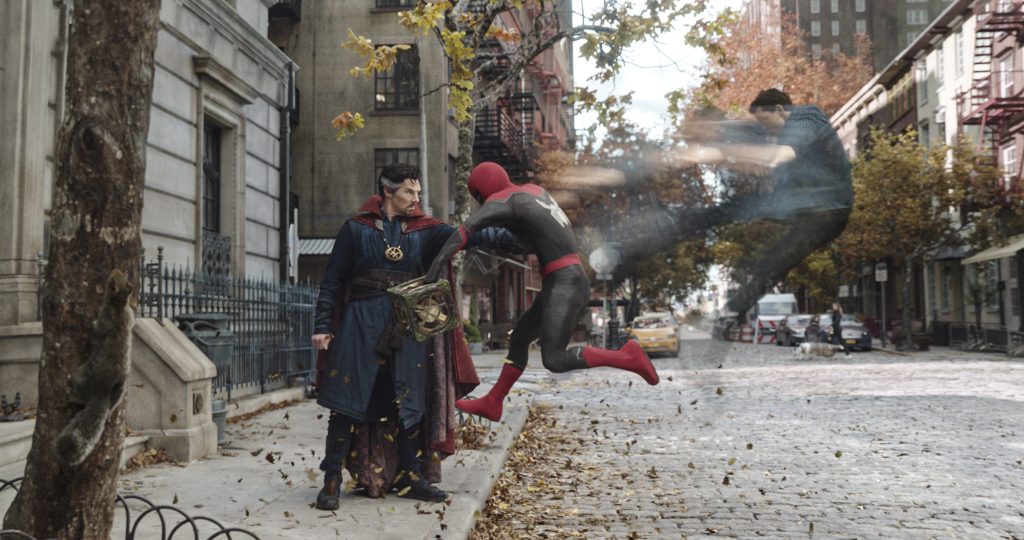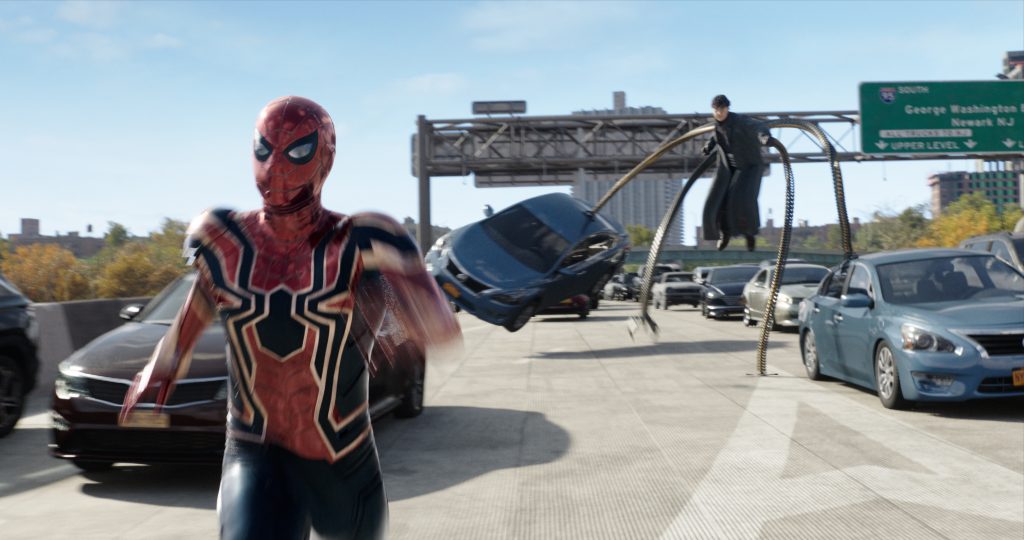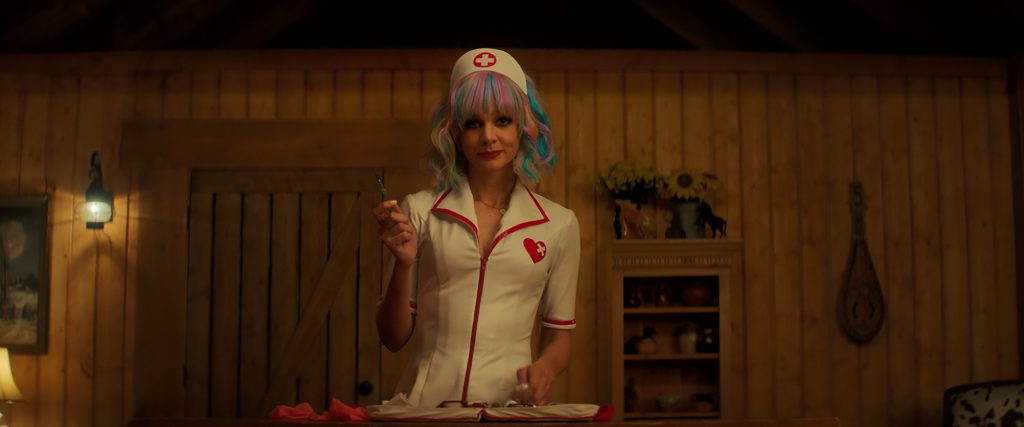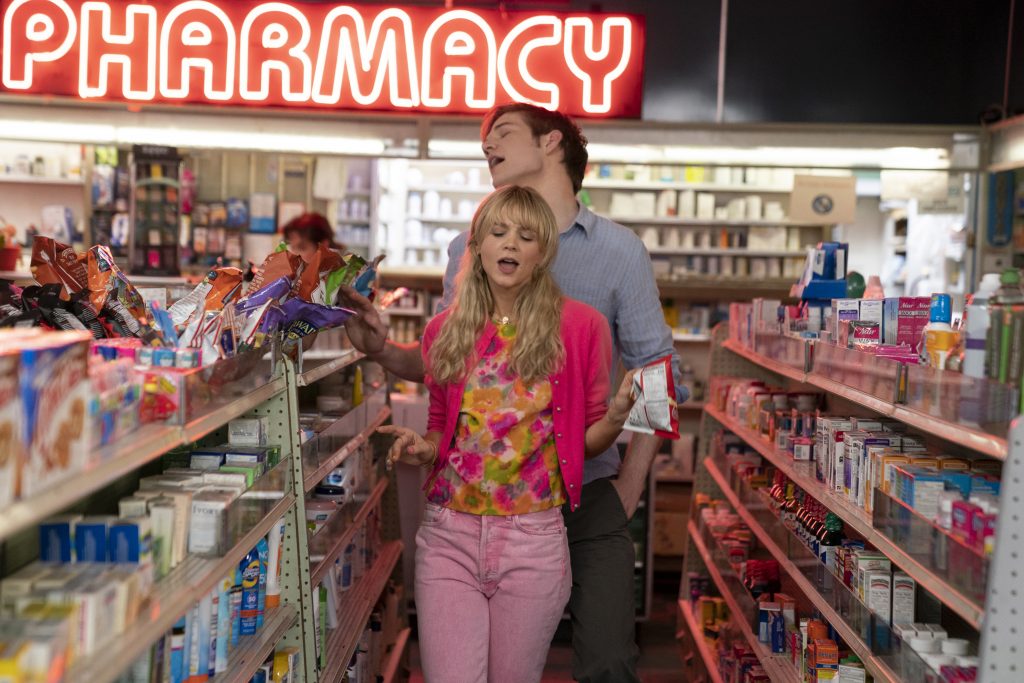July 26, 2022
by Carla Hay
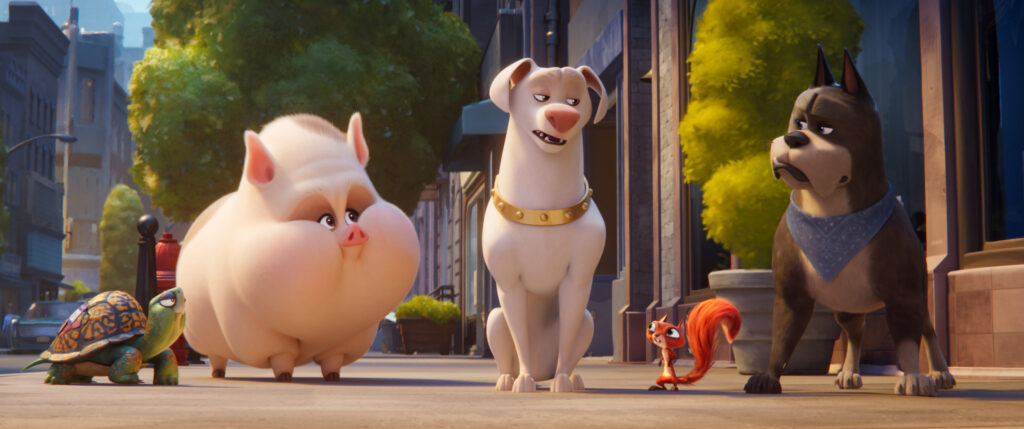
Directed by Jared Stern; co-directed by Sam Levine
Culture Representation: Taking place primarily in the fictional city of Metropolis, the animated film “DC League of Super-Pets” features a racially diverse cast (white, black, Asian and Latino) portraying talking animals, superheroes and citizens of Metropolis.
Culture Clash: Inspired by DC Comics characters, “DC League of Super-Pets” features a group of domesticated pets, including Superman’s dog Krypto, fighting crime and trying to save the world from an evil guinea pig that is loyal to supervillain Lex Luthor.
Culture Audience: “DC League of Super-Pets” will appeal primarily to fans of DC Comics, the movie’s cast members and adventure-filled animated movies centered on talking animals.
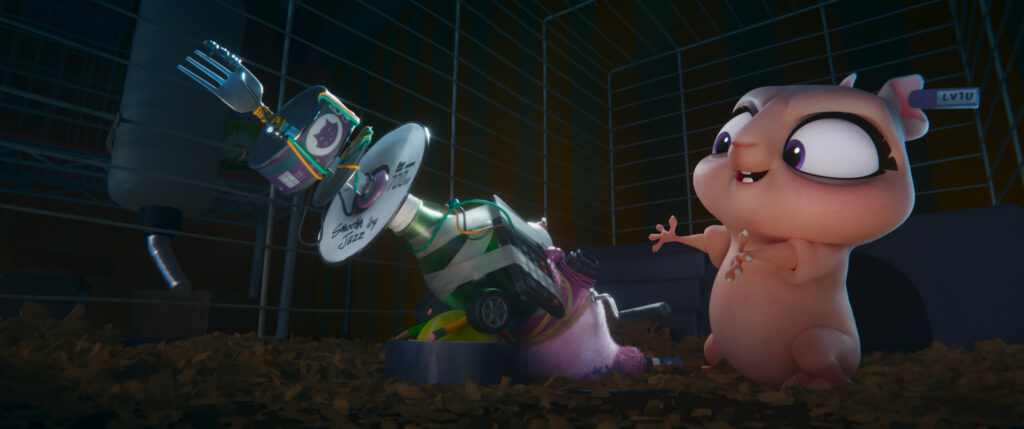
Even though “DC League of Super-Pets” sometimes gets cluttered with subplots and characters, this animated film is a treat that has a winning combination of pets and superheroes. There’s plenty to like for people of many ages. In addition to the appeal of having familiar characters from DC Comics, “DC League of Super-Pets” is a well-cast film for its voice actors, because the cast members bring their own unique flairs to the characters. It’s helpful but not necessary to have knowledge of DC Comics characters before watching this movie.
Directed by Jared Stern and co-directed by Sam Levine, “DC League of Super-Pets” makes good use of mixing zany comedy, engaging action and some heartwarming and touching moments. Stern makes his feature-film directorial debut with “DC League of Super-Pets,” which he co-wrote with John Whittington. Stern and Whittington also co-wrote 2017’s “The Lego Batman Movie.” Where “DC League of Super-Pets” falters is when it tries to cram in certain plot developments to the point where “DC League of Super-Pets” comes dangerously close to biting off more than it can chew. (No pun intended.)
If you have no interest in watching an animated movie about pets and would-be pets of superheroes, then “DC League of Super-Pets” probably is not for you. The world already has more than enough animated films about talking animals. However, “DC League of Super-Pets” mostly succeeds at being entertaining when putting comic book characters in a predictable but dependable story of a group of misfits that become friends while trying to save the world.
“DC League of Super-Pets” begins by showing how Superman (whose birth name is Kal-El) ended up with his loyal Labrador Retriever dog Krypto. Kal-El was born on the planet Krypton. When he was a baby, Krypton went under attack, so his parents put Kal-El on a spaceship alone and sent him to Earth for his safety. Kal-El’s parents Jor-El (voiced by Alfred Molina) and Lara (voiced by Lena Headey) say their emotional goodbye to Kal-El.
Jor-El says, “Krypton is about to die.” Lara adds, “But you, dear son, will live on.” Suddenly, the family’s Labrador Retriever puppy jumps on the spaceship with Kal-El. At first, Jor-El wants to try to get the dog back, but the space ship has already been set in motion. Lara tells Jor-El: “Our boy will need a friend.” Jor-El says to the dog: “Watch over our son.”
Years later, Kal-El is now an adult living in the big city of Metropolis under the name Clark Kent. He’s a bachelor who works as a reporter at the Daily Planet newspaper, but Clark Kent is an alter ego to his secret identity: a superhero named Superman (voiced by John Krasinski), who has super-strength, X-ray vision and the ability to fly. The dog, named Krypto (voiced by Dwayne Johnson), is still his loyal companion and knows about the secret life of Superman, because Krypto often fights crime alongside Superman.
Krypto has superpowers that are the same as Superman’s superpowers. And they both have the same weakness: an energy force called kryptonite that can drain their superpowers. Krypto and Superman are a lot alike, when it comes to how they view crime and justice. However, Superman and Krypto are very different when it comes to adapting to life on Earth: Superman/Clark Kent is social with humans, while Kypto is very aloof with other pets on Earth.
An early scene in the movie shows Krypto trying to get Superman to wake up because Krypto wants to go for a walk. But “walking the dog” for Superman really means “flying through the air with the dog.” Krypto often leads the way on the leash. The Metropolis in “DC League of Super-Pets” is designed to look like a modern, well-kept city with many tall buildings, just like in the comic books.
In this version of Metropolis, Superman is such a familiar sight, no one really thinks it’s unusual to see Superman in a park with his dog Krypto. It’s during one of these park outings that Krypto sees that things at home will soon change for Superman and Krypto. Superman/Clark Kent and his Daily Planet journalist co-worker Lois Lane (voiced by Olivia Wilde) are very much in love, and they meet at the park for a date. They show lovey-dovey public displays of affection, much to Krypto’s dismay.
The relationship between Superman/Clark Kent and Lois has gotten serious enough where it looks like this couple could be headed toward marriage. Krypto is jealous and fearful that Superman/Clark Kent will no longer have the time and attention for Krypto if Lois moves in with them. Krypto doesn’t dislike Lois. Krypto just sees her as a threat to the comfortable existence he has always known with Superman/Clark Kent.
As Krypto worries about how his home life will change if Lois moves in, some other pets in Metropolis are worried if they’ll ever have a permanent home. At an animal shelter called Tailhuggers, several pets are up for adoption, but so far, they have no takers. The shelter is run by a bachelorette named Patty (voiced by Yvette Nicole Brown), who is very kind to the pets and keeps them under vigilant protection.
Brash and sarcastic hound dog Ace (voiced by Kevin Hart) is the leader of the shelter pets. Other animals at the shelter are elderly turtle Merton (voiced by Natasha Lyonne), cheerful pig PB (voiced by Vanessa Bayer) and nervous squirrel Chip (voiced by Diego Luna), who are Ace’s closest friends at the shelter. Also at the shelter is a cat name Whiskers (voiced by Winona Bradshaw), whose loyalty to the shelter pets is later tested.
Ace is anxious to run away from the shelter and is constantly plotting his escape. He tells his animal shelter friends that he knows of a paradise-like farm upstate where they can all go to live freely. One day, Ace actually manages to run away from the shelter, but he doesn’t go far. He’s literally stopped in his tracks by “law and order” Krypto, who uses his superpowers to freeze Ace’s legs to the sidewalk when he sees that Ace is a runaway shelter dog. Needless to say, Ace and Krypto clash with each other the first time that they meet.
Meanwhile, Superman has a crime-fighting incident where he summons the help of his Justice League superhero colleagues: Batman (voiced by Keanu Reeves), Wonder Woman (voiced by Jamila Jamil), Aquaman (voiced by Jemaine Clement), Green Lantern (voiced by Dascha Polanco), The Flash (voiced by John Early) and Cyborg (voiced by Daveed Diggs). Through a series of incidents, all of these superheroes are captured by billionaire supervillain (and longtime Superman nemesis) Lex Luthor (voiced by Marc Maron), who is keeping his captives hidden in a secret lair. Lex also has a cynical assistant named Mercy Graves (voiced by Maya Erksine), who isn’t in the movie as much as she could have been. Mercy’s screen time is less than five minutes.
All of that would be enough of a plot for this movie, but “DC League of Super-Pets” also has a plot about a devious guinea pig named Lulu (voiced by Kate McKinnon), who manages to escape from a Lex Luthor-owned scientific lab that was experimenting on guinea pigs. Somehow, Lulu gets ahold of orange kryptonite (she’s immune to kryptonite), she develops telekinesis powers, and goes on a mission to prove her loyalty to Lex by trying to destroy the Justice League.
Lulu has an army of former lab guinea pigs to do her bidding. Two of Lulu’s most loyal of these accomplices are mutant guinea pigs that also have newfound superpowers: Mark (voiced by Ben Schwartz) is fiery red and can shoot flames, while Keith (voiced by Thomas Middleditch) is ice-blue and has the ability to freeze things. Lulu also has a plot to (cliché alert) take over the world.
It should come as no surprise that Krypto ends up joining forces with Ace, Merton, PB and Chip to try to save the Justice League and save the world. During the course of the story, certain superpowers are gained, lost and possibly gained again for certain characters. Viewers of “DC League of Super-Pets” should not expect the Justice League superheroes and Lex Luthor to get a lot of screen time, because the movie is more about the pets.
Lulu’s revenge plot gets a little convoluted, but not so confusing that very young children won’t be able to understand. The movie has the expected high-energy antics, with animation and visual effects that aren’t groundbreaking but are aesthetically pleasing on almost every level. Once viewers get used to all the characters that are quickly introduced in the movie, it makes “DC League of Super-Pets” more enjoyable.
The movie has some recurring jokes, such as self-referencing all the movies and licensing deals that come from comic-book superheroes. “DC League of Super-Pets” also has a running gag of guinea pig Lulu being insulted when she’s often misidentified as a hamster. After one such misidentification, Lulu snarls, “A hamster is just a dollar-store gerbil!”
Lulu has some of the funniest lines in the movie. When she sees the DC League of Super-Pets together, she makes this snarky comment: “What is this? PAW Patrol?” And even though Batman isn’t in the movie for a lot of time, he also has some memorable one-liners, which he delivers in a deadpan manner.
It soon becomes obvious that these Super-Pets have another purpose besides saving the world: Each pet will be paired with a Justice League superhero. PB is a big fan of Wonder Woman. This star-struck pig thinks that Wonder Woman has the confidence and independent spirit that PB thinks is lacking in PB’s own personality.
Turtles are known for walking slow, so it should come as no surprise that Merton admires The Flash, whose known for his superpower of lightning-fast speed. Ace sees himself as an “alpha male” who strikes out on his own when he has to do so, which makes Batman a kindred spirit. Chip is attracted to the fearlessness of Green Lantern. As for Aquaman and Cyborg, it’s shown at the end of the movie which pets will be paired with them.
Amid the action and comedy, “DC League of Super-Pets” also has some meaningful messages about finding a family of friends. Ace has a poignant backstory about how he ended up at an animal shelter. Ace’s background explains why he puts up a tough exterior to hide his vulnerability about being abandoned.
Johnson (who is one of the producers of “DC League of Super-Pets”) and Hart have co-starred in several movies together. Their comedic rapport as lead characters Krypto and Ace remains intact and one of the main reasons why “DC League of Super-Pets” has voice cast members who are perfectly suited to each other. Hart is a lot less grating in “DC League of Super-Pets” than he is in some of his other movies, where he often plays an over-the-top-buffoon.
Even though Ace is an animated dog, he has more heart than some of the human characters that Hart has played in several of his mediocre-to-bad movies, Law-abiding Krypto and rebellious Ace have opposite personalities, but they learn a lot from each other in ways that they did not expect. All of the other heroic characters have personal growth in some way too.
“DC League of Super-Pets” is a recommended watch for anyone who wants some escapist animation with entertainment personalities. The movie’s mid-credits scene and end-credits scene indicate that “DC League of Super-Pets” is the beginning of a movie series. It’s very easy to imagine audiences wanting more of these characters in movies if the storytelling is good.
Warner Bros. Pictures will release “DC League of Super-Pets” in U.S. cinemas on July 29, 2022.

